Baby marmosets imitate parents’ sounds
First evidence of a primate other than humans using vocal feedback to shift from cries to adult communication

CALL ME New research suggests that marmoset babies, like the one shown here with its mother, learn to make communication sounds known as “phees” by getting vocal feedback from their parents. Marmosets share a neural program for early vocal learning with songbirds and humans, investigators suspect.
Iuliia Timofeeva/shutterstock
Small monkeys with white tufts of ear hair and long, striped tails may reveal some surprising new insights into how human infants learn to make speech sounds.
During the first two months of life, common marmoset monkeys (Callithrix jacchus) transform their initial cries into whistlelike calls known as “phees,” at least in part by imitating their parents’ well-timed calls, says a team led by psychologist Asif Ghazanfar of Princeton University. This is the first evidence of a nonhuman primate using vocal feedback early in life to learn how to produce mature communication sounds, the researchers report in the Aug. 14 Science.
Vocal learning plays out in marmosets much as it does in humans and songbirds, the researchers propose. In each, certain early vocal sounds gradually get modified into mature sounds via physical maturation and the experience of hearing and copying adult sounds.
A better understanding of brain areas involved in developing marmoset calls may provide a guide to untangling neural problems in young children with speech disorders, Ghazanfar suggests. “Our findings herald the marmoset monkey as a great model system for understanding the neurobiology of early vocal communication in humans and its disorders,” he says.
An ancient brain capacity for vocal learning laid the groundwork for human language learning, suggests zoologist Ofer Tchernichovski of City University of New York’s Hunter College. Tchernichovski leads a team that studies vocal development in songbirds.
Early vocal learning probably occurs in highly cooperative mammal and bird species that place a premium on communication among individuals, Tchernichovski and University of Chicago biologist Daniel Margoliash propose in a comment published in the same issue of Science.
Ghazanfar agrees. His group previously found that marmosets maintain contact when separated from other group members by exchanging “phee” calls. Vocal communication also helps to coordinate cooperative infant care, he says in the new study. Like humans, marmosets depend on parents, older siblings and other group members to help care for infants. Animals that lack cooperative infant care, such as macaque monkeys and chimpanzees, don’t exhibit early vocal learning, Ghazanfar suspects.
He and his colleagues evaluated the acoustic properties of sounds — including the length of vocalizations — made by 10 common marmosets from the first day after birth to two months of age. Baby monkeys were recorded while they were briefly alone and could not hear any of their group mates, as well as when they could hear, but not see, their mothers or fathers vocalizing.
Infants started out making acoustically indistinct cries and then slightly more discrete sounds, both of which the researchers regard as precursors of “phees.” Increases in respiratory function accompanied monkeys’ expanding use of “phee” sounds. Physical maturation of the lungs and larynx, or voice box, stabilizes breathing and helps young marmosets to produce “phee” sounds, Ghazanfar says.
But maturation displayed little relation to infants’ rapid shifts to producing more “phees” than cries. The timing of those changeovers varied from around 10 days to 40 days after birth. Rates of physical growth, indicated by weight gains, did not correspond closely to monkeys’ vocal transitions. Instead, babies who received the greatest number of vocal responses from their parents within five seconds of making their own call sounds showed the earliest vocal advances.
Early and late transitions to adult call sounds among six marmoset siblings, each with the same mother and father, also corresponded to the varying numbers of vocal responses each of them received from their parents. So it’s unlikely that a genetic tendency in some families to produce “phee” sounds early or late in infancy explains the results, Ghazanfar says.
Marmosets and humans probably share a basic brain system for early vocal learning, although further studies with larger numbers of marmosets are needed to confirm the new results, says psycholinguist D. Kimbrough Oller of the University of Memphis. Early vocal development is more complex in people than in marmosets, Oller adds (SN: 5/4/13, p. 17).







